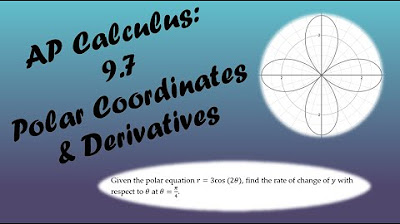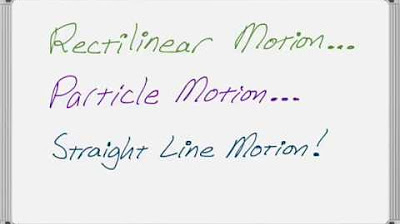Motion Along a Polar Curve
TLDRThis video discusses particle motion along polar curves, focusing on three examples. It explains how to find derivatives with respect to time using implicit differentiation and interprets the results in the context of particle motion. The examples include a particle moving along a cardioid curve, a polar curve defined by a function of theta, and a curve where the distance from the origin increases at a constant rate.
Takeaways
- 📘 Particle motion along polar curves can appear in free response questions on the Calculus BC exam.
- 🧮 The first example involves a particle moving along the polar curve R = 1 + cos(θ) with dθ/dt = 1/5. The task is to find dr/dt at θ = π/2 and interpret its meaning.
- 📉 To find dr/dt, take the derivative of both sides of R = 1 + cos(θ) with respect to time, using implicit differentiation.
- 📐 When θ = π/2 and dθ/dt = 1/5, the derivative dr/dt is -1/5, indicating the particle is moving towards the origin.
- 🧩 The second example involves a particle moving along the polar curve f(θ) = θ² with dθ/dt = 2. The task is to find the rate at which y changes with respect to time at θ = 2π/3.
- ✏️ To find dy/dt, use the product rule on y = r*sin(θ), where r = f(θ).
- 🔗 When θ = 2π/3 and dθ/dt = 2, dy/dt is positive, indicating the particle is moving counterclockwise.
- ⏱️ The third example is from the 2018 BC exam and involves a particle moving such that the distance from the origin increases at a constant rate of 3 units per second. The task is to find dθ/dt.
- 🔍 Using implicit differentiation and the given rate, solve for dθ/dt, which equals 3/√3, indicating a specific rate of angular change.
- 🔄 The chain rule can be applied as dy/dt = (dy/dθ) * (dθ/dt) to simplify the differentiation process.
Q & A
What is the topic of the video?
-The video discusses particle motion along a polar curve, particularly in the context of the AP Calculus exam.
Why is it important to understand particle motion along a polar curve for the AP Calculus exam?
-It is important because such problems can occasionally appear in the free response questions on the AP Calculus exam.
How many examples are used in the video to explain particle motion along a polar curve?
-Three examples are used in the video to explain the concept.
What is the first example's polar curve equation and what is the given condition?
-The first example's polar curve equation is R = 1 + cos(Theta), with the condition that dTheta/dt = 1/5 for all time T.
What is the value of dr/dt at the point where Theta is pi/2 in the first example?
-The value of dr/dt at the point where Theta is pi/2 is -1 * (1/5), which simplifies to -1/5.
What is the second example's polar curve and the condition given for dTheta/dt?
-In the second example, the polar curve is f(Theta) = Theta^2, and the condition is that dTheta/dt = 2 for all time T.
What is the rate of change of y with respect to time at Theta = 2pi/3 in the second example?
-The rate of change of y with respect to time at Theta = 2pi/3 is a positive number, calculated using the product and chain rules.
What is the third example's condition regarding the rate of change of the distance between the particle and the origin?
-In the third example, the distance between the particle and the origin increases at a constant rate of 3 units per second.
What is the rate of change of Theta with respect to time in the third example?
-The rate of change of Theta with respect to time is 3 over the square root of 3, which simplifies to approximately 1.732 radians per second.
How does the video suggest interpreting the meaning of the rate of change in the context of particle motion?
-The video suggests interpreting the rate of change in terms of the direction and speed of the particle's movement along the curve, considering the increasing or decreasing values of the variables involved.
What alternative method is mentioned in the video for calculating the rate of change of y with respect to time?
-An alternative method mentioned is to take the derivative of the expression normally and then multiply the entire expression by dTheta/dt, which is a valid approach due to the chain rule.
How does the video address the units of measure for the rate of change of Theta?
-The video discusses that the units for the rate of change of Theta should be in radians per second, as it represents an angular measure rather than a distance.
Outlines
📚 Particle Motion on Polar Curves: Calculus BC Exam Insights
This paragraph introduces the topic of particle motion along a polar curve, a concept that may appear in free response questions on the AP Calculus BC exam. The speaker proposes to work through three examples to illustrate the process. The first example involves finding the rate of change of the radial distance 'r' with respect to time 't' for a particle moving along a curve defined by 'R = 1 + cos(Theta)' with a given angular velocity. Implicit differentiation is used to solve the problem, emphasizing that the curve's appearance is not necessary for the solution. The explanation includes taking derivatives with respect to time, applying the chain rule, and plugging in specific values to find the rate of change at a particular point on the curve.
🔍 Analyzing Particle Motion: Derivatives and Interpretation
This paragraph continues the discussion on particle motion along polar curves, focusing on the second example where the particle's angular velocity is constant, and the rate of change of 'y' with respect to time 't' is sought. The formula for 'y' in terms of 'R' and 'Theta' is derived, and the product rule is applied to find 'dy/dt'. The speaker then substitutes specific values for 'Theta' and 'dTheta/dt' to find the rate of change of 'y'. The paragraph also touches on the interpretation of the results in the context of the particle's motion, explaining the significance of the direction of motion and the implications of the sign of the rate of change on the particle's trajectory. Additionally, the speaker discusses alternative methods for solving such problems, including multiplying the derivative of the expression by 'dTheta/dt', and emphasizes the importance of understanding the physical meaning behind the mathematical operations.
Mindmap
Keywords
💡Particle Motion
💡Polar Curve
💡Implicit Differentiation
💡Derivative
💡Chain Rule
💡Free Response Questions
💡Rate of Change
💡Theta (Θ)
💡Radian
💡Graph Interpretation
Highlights
Introduction to the topic of particle motion along a polar curve, which can appear in the free response questions on the AP Calculus exam.
Explanation of the first problem involving a particle moving along the polar curve R = 1 + cos(Θ) with dΘ/dt = 1/5 and finding dr/dt at Θ = π/2.
Use of implicit differentiation to solve the first example without needing to visualize the curve.
Derivation of dr/dt by taking the derivative of R with respect to time, considering R and Θ as functions of time T.
Substitution of known values into the derived equation to find the rate of change of the radial distance at a specific point.
Introduction of the second problem with a particle moving along the polar curve f(Θ) = Θ^2sin(Θ) with dΘ/dt = 2 and finding the rate of change of y with respect to T at Θ = 2π/3.
Expression for y in terms of R and Θ, and the need for the product rule to find dy/dt.
Application of the product rule and chain rule to find the derivative of y with respect to time T.
Substitution of specific values for Θ and dΘ/dt to calculate the rate of change of y at a given point.
Introduction of the third problem from the 2018 BC exam, involving a particle moving such that the distance from the origin increases at a constant rate.
Derivation of dr/dt for a particle moving at a constant rate from the origin and finding dΘ/dt.
Interpretation of the rate of change of Θ with respect to time in the context of the particle's motion.
Discussion on the units of measure for dΘ/dt and the implications for the particle's angular velocity.
Clarification on the use of the chain rule in the context of the problems and its relation to the rate of change of variables.
Graphical interpretation of the particle's motion on the polar curve and the significance of dΘ/dt in determining the direction of motion.
Conclusion summarizing the importance of understanding particle motion along a polar curve for AP Calculus exam preparation.
Transcripts
Browse More Related Video

2 | FRQ (Calculator Active) | Practice Sessions | AP Calculus BC

Related Rates - Distance Problems - Application of Derivatives

AP Calculus BC Lesson 9.7

Polar, Parametric, Vector Multiple Choice Practice for Calc BC (Part 1)

More on Polar Graphs

Rectilinear Motion or Particle Motion or Straight Line Motion!
5.0 / 5 (0 votes)
Thanks for rating: